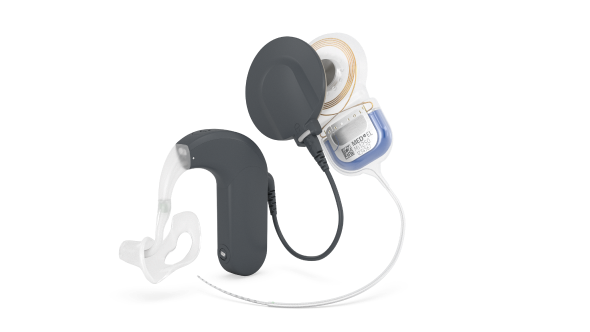Electric Acoustic Stimulation
If you have trouble hearing high-pitched sounds, discover how an Electric Acoustic Stimulation (EAS) system could give you the joys of sound.

What is EAS?
Are certain sounds easier to hear than others? Do people always sound as if they're mumbling? Do you feel that your hearing aids are just not good enough?
If this sounds familiar, you may be missing out on hearing high-pitched sounds. When you cannot hear high-pitched sounds, you have a type of hearing loss known as high-frequency hearing loss. This type of hearing loss is common in both children and adults.
EAS is the combination of two technologies: cochlear implant technology for high-pitched sounds, and hearing aid technology for low-pitched sounds. By using two different technologies in one device, you can hear the full range of sounds, making it much easier to chat with friends, enjoy music, and communicate in everyday life.
Low-Pitched Sounds—Hearing Aid Technology



 1
2
3
1
2
3 - 1Sounds are detected by the microphones of the audio processor.
- 2Low-pitched sounds are made louder and sent through the earmold to the ear.
- 3These sounds are processed by the cochlea and sent to the brain.
High-Pitched Sounds—Cochlear Implant Technology



 1
2
3
1
2
3 - 1Sounds are detected by the microphones of the audio processor.
- 2High-pitched sounds are sent to the implant as electrical signals.
- 3These sounds are processed by the cochlea and sent to the brain.

More Than Just Hearing
EAS is proven to give you better hearing. And better hearing has many more benefits for your lifestyle, including:
- Easier to socialise with friends
- Improved relationship with family members
- Better hearing in noisy settings, like restaurants
- Easier listening on the phone

The Perfect Match
Your EAS system consists of two parts: the implant and the audio processor. The audio processor is worn on the outside of your head, sitting comfortably on your ear. It contains the microphones that pick up the sounds around you, and then sends these sounds to your implant and the earmold in your ear. You’ll wear your audio processor all day every day, except when you’re asleep.
The implant is surgically placed just under your skin, and works with your audio processor to let you hear sounds as naturally as possible. This part of the system will be with you for many years to come, so you should keep the future in mind when choosing your implant.
And with the help of our apps, you can make hearing with your EAS system even simpler and more convenient.


SYNCHRONY 2 for EAS
Great sound quality is only possible with a great implant. With SYNCHRONY 2 you can benefit from the latest EAS technology and our MRI Guarantee.
But the biggest advantage of SYNCHRONY 2 is that it mimics natural hearing. The result? The closest to natural hearing of any cochlear implant system.
Discover More

Be Flexible. Be Free.
Smaller and lighter than SONNET 2 EAS and equipped with integrated direct streaming, SONNET 3 EAS offers you freedom and flexibility. Experience closest to natural hearing with our latest behind-the-ear audio processor.
-
AdultsVIBRANT SOUNDBRIDGEGerman
Jonas
VIBRANT SOUNDBRIDGE
Watch video
-
AdultsCI System EAS SystemEnglish

Laura Part 1
CI System EAS System
See profile
-
AdultsEAS SystemEnglish

Sherri
EAS System
See profile
-
AdultsEAS SystemDutch English German
Denise
EAS System
Watch video
The Next Steps
What can you expect next? Here’s an outline of the process of receiving a cochlear implant.
We’re Here for You on Your Hearing Journey
Would you like to find out more about how MED-EL’s hearing solutions could help you or someone you care for? Simply fill out the contact form and we will provide you with further information.



